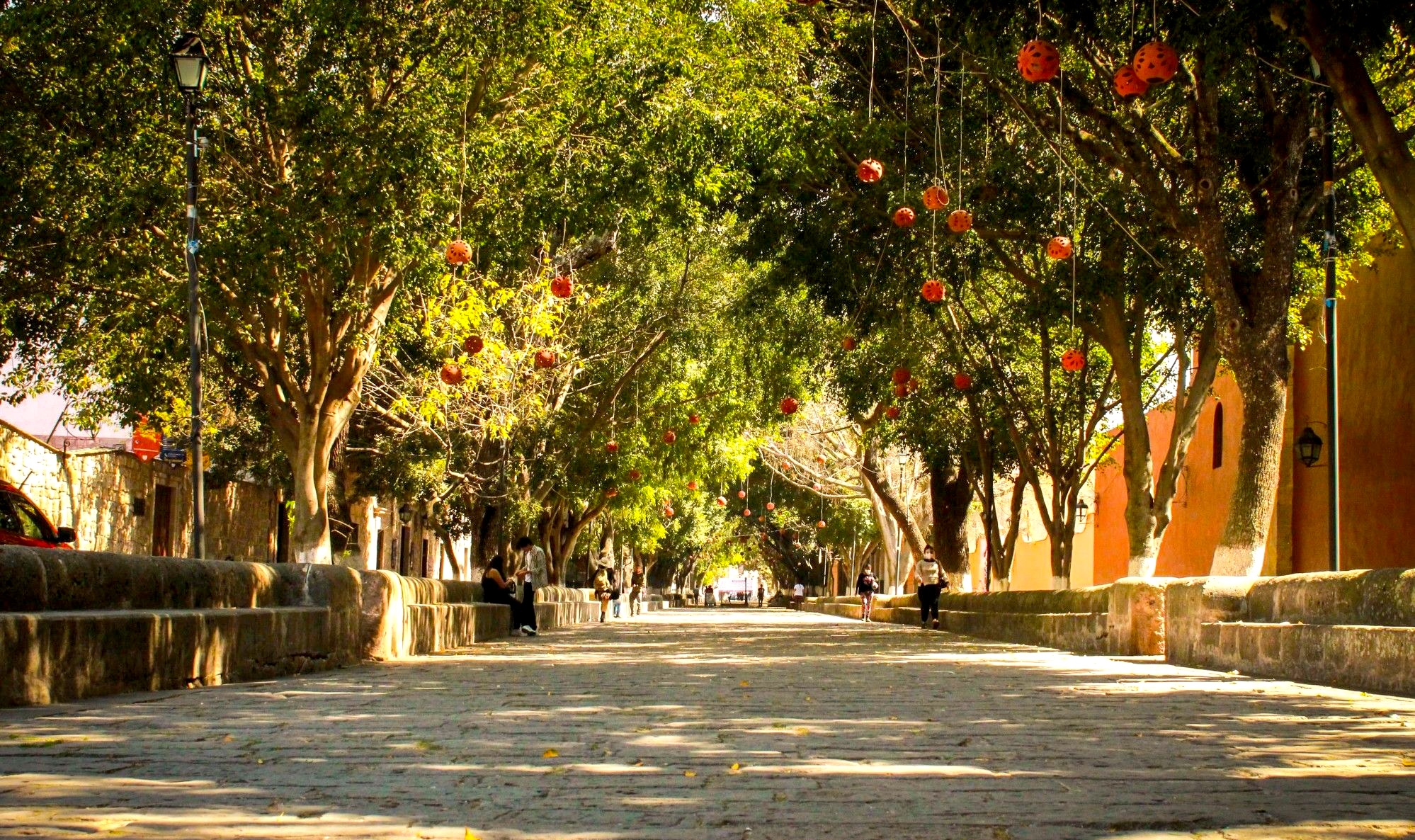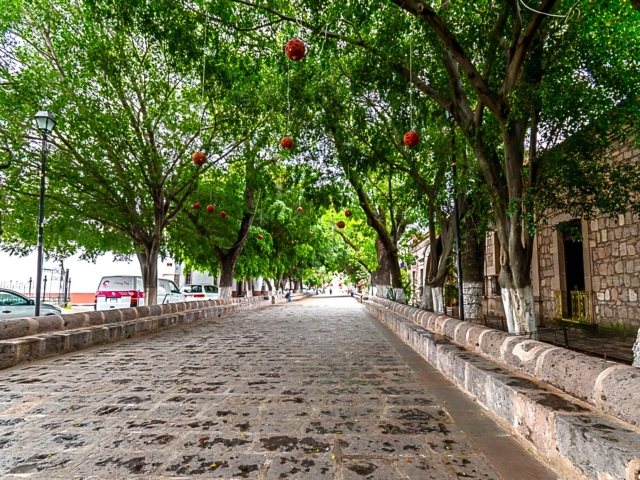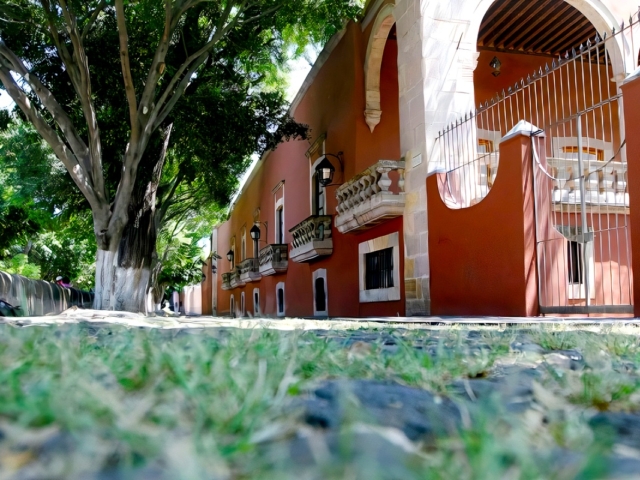
Adress
Calle Fray Antonio de San Miguel, Centro, 58000 Morelia, Michoacán, México.
GPS
19.702701369343, -101.18202745914
KNOW MORE PLACES
VISITA OTRAS LOCALIDADES
Popularly known as “Calzada de San Diego”, the most beautiful and famous promenade in Morelia is located in what was formerly the northern limit of the town of San Pedro Apóstol.
This neighborhood of indigenous people, brought from other places (mainly from the shores of Lake Pátzcuaro) to populate the city of Valladolid with labor, is now the Cuauhtémoc Forest.
The original construction of the road dates back to 1732, when Juan José Escalona y Calatayud saw the need for a decent road to the recently founded Sanctuary of Guadalupe, of the Order of San Diego.
Through the ecclesiastical council he ordered that it be done from the first arch of the aqueduct that runs north, to the wall of the cemetery of the aforementioned temple.
The cemetery no longer exists; it is currently a small square in front of the temple, which is distinguished by being surrounded by chains and inside which there are only quarry tiles and an old tree.
At that time it was known as Calzada de Guadalupe, and was made of simple cobblestones.
It was originally paved, but was later paved with pink quarries.
At the end of the 18th century, improvements were made to this work: the paving was removed and quarry tiles were placed.
In addition to the windows and handrails of the same material, there were twelve long benches in total, six facing north and six facing south.
Ash trees were also planted, which over time grew and gave the walk a unique appearance, creating shade along its length.
Improvements were also made to the road, replacing part of the quarry tiles that made it up and refurbishing the benches.
This was around the year 1784, on the initiative of Fray Antonio de San Miguel, Bishop of the city.
Al mismo tiempo se reconstruyó el city aqueduct, in a stretch of approximately two kilometers in length,
Between 1849 and 1854, street lamps were installed to facilitate night-time traffic on the road.
This matched the Alameda, a promenade surrounded by poplars and with a fountain in the center of a gazebo, today the Morelos Garden; and the Paseo de San Pedro, today the Cuauhtémoc Forest.
Between 1868 and 1870 the benches were given their definitive form, which has been preserved to this day.
Towards the north side, where Fray Antonio de San Miguel Street runs today, the tram circulated, first with mules, and then electric.
This one circulated between the general hospital, the railway station and the municipal cemetery.
On its south side, part of the cobblestones that formed a street still exist and the sidewalks still retain their iron strips.
Between 1935 and 1936 it underwent maintenance work, the last of which took place between 2000 and 2004.
Not only is it beautiful, but it is surrounded by architecture, history and art.
Among the buildings and monuments that surround it, the Aqueduct stands out, one of whose highest arches is the starting point of the road.
On the columns of this one there are two marble plaques, where in 1884 a thank you was given to Fray Antonio de San Miguel for his sponsorship of the works of the reconstruction of the aqueduct, one is written in Spanish and the other in Latin.
At its north-west end is the old Chapel of Señor del Rincón, today the Chapel of Lourdes.
One block further east is the former home of Dr. Miguel Silva González, son of the liberal and also Dr. Miguel Silva Macías; both were governors of the state.
Miguel Silva González supported the cause of Francisco I. Madero, and as provisional governor of the state in 1913, he inaugurated on May 2 the equestrian monument to Don José María Morelos y Pavón, which is located in the old Alameda, to the south-east of the road.
At one end is one of the most famous houses in Morelia, the one with the hand on the fence.
On the south-west side, the road is bordered by flowerbeds, and the first house on its south side is the famous house of Martín García de Carrasquedo.
Known today as Casa Alfonso Rubio y Rubio, although people refer to it more as the house with the hand on the fence, due to the local legend of the same name, which alludes to the fact that a jealous woman locked her beautiful stepdaughter in the basement of the house, to prevent her from seeing her lover.
This story ends with a fatal outcome for the protagonist, named Leonor Núñez de Castro, of whom it is said there is a portrait in the aforementioned house.
En su parte nor-oriente, la calzada conduce al Jardín Azteca, llamado así por los motivos arquitectónicos y pequeñas construcciones que hacen alusión a tal cultura.
El nombre correcto del jardín es Fray Antonio de Lisboa, pero el común de la gente se refiere a él con el nombre de Azteca.
En su extremo oriente la calzada llega al antiguo cementerio, que junto con la Avenida Tata Vasco, conducen a la entrada del templo, el Santuario de Nuestra Señora de Guadalupe de San Diego de San Francisco, construido entre 1708 y 1716.
A un lado se encuentra la actual Facultad de Derecho y Ciencias Sociales, antiguo convento de San Diego de San Francisco, construido también en 1732.
Es uno de los caminos que llevan al Monumento Ecuestre al Generalísimo: Morelos
A su costado sur-oriente se encuentra una explanada cívica y el Jardín Morelos, donde está el monumento ecuestre al más grande héroe de la ciudad, en bronce trabajado por el maestro Giusepe Inghilleri entre 1908 y 1912.
Fue vaciado en la fundición Nelli de Roma, y consta de una base de cantera de Pátzcuaro y cinco bronces.
El del sur representa a la justicia, el del norte a la patria (ambas esculturas basadas en los cuerpos de dos distinguidas y bellas damas morelianas, las hermanas Fourier).
La del oriente el rompimiento del sitio de Cuautla, la del poniente el Congreso de Anáhuac en Chilpancingo.
El quinto bronce representa a Morelos en su cabalgadura, viendo al norte, rumbo al cual se dirigió para encontrar al Cura Hidalgo y unirse a la insurgencia.
Desde su creación, la calzada ha ostentado diversos nombres: Calzada de San Diego, Calzada de Guadalupe y Calzada Dr. Miguel Silva.
A partir del decreto municipal de 1929 que estableció la cuarta y actual nomenclatura de la ciudad, a la calzada y a la calle que corre al norte de la misma, se les denominó como Fray Antonio de San Miguel.
Desde el siglo XIX, durante el XX y hasta el día de hoy es uno de los sitios más visitados de la ciudad de Morelia
Se llevan a cabo en sus más de 400 metros de longitud actividades culturales, como exposiciones de esculturas, de fotografías o caminos de velas.
En época de día de muertos, del Festival Internacional de Música Miguel Bernal Jiménez o el muy reciente Internacional de Cine, se realizan composiciones artesanales de flores, aserrín y otros materiales naturales, conformando instalaciones de belleza sobrecogedora.
Es sitio obligado de visita en los tours de tranvías que parten a un costado de Catedral, tanto por su belleza como por la leyenda de la mano en la reja.
Pero más importante aún, es una zona de relevancia para la historia de la ciudad.










